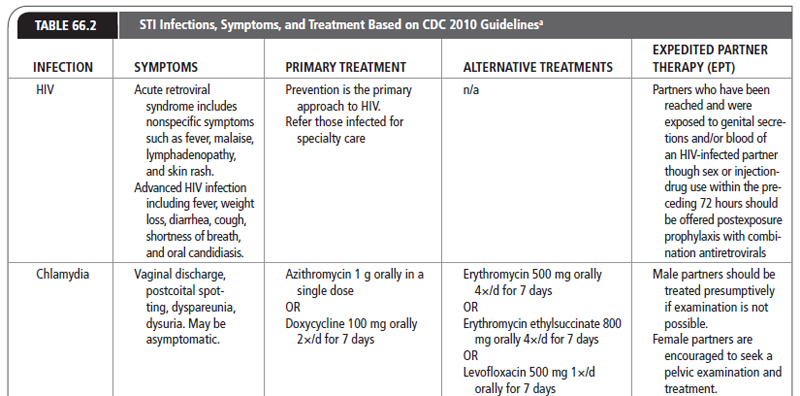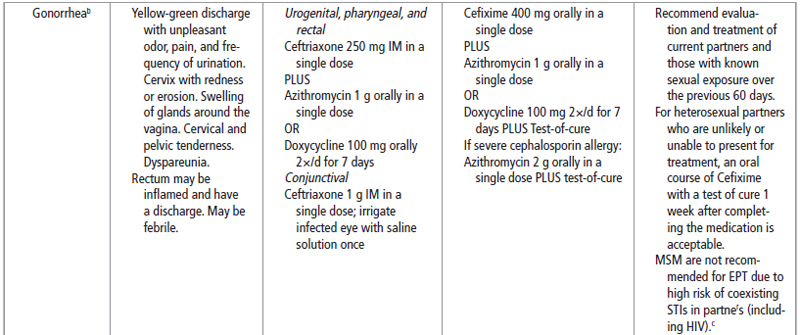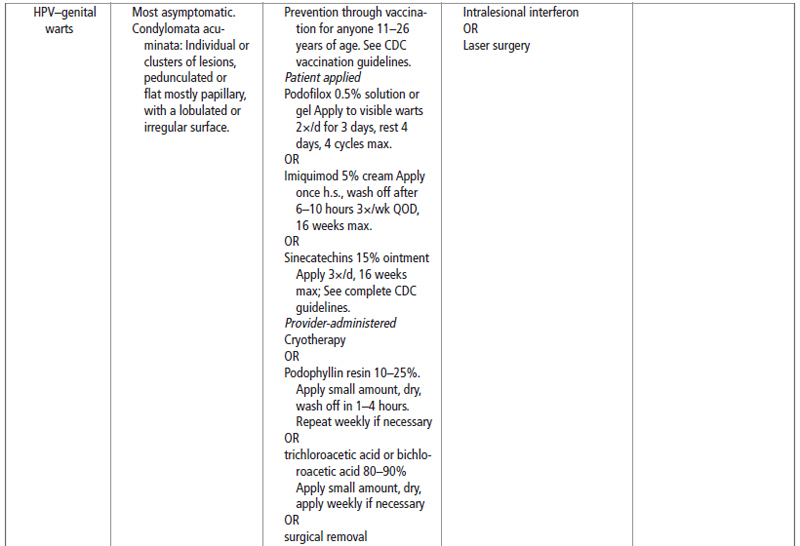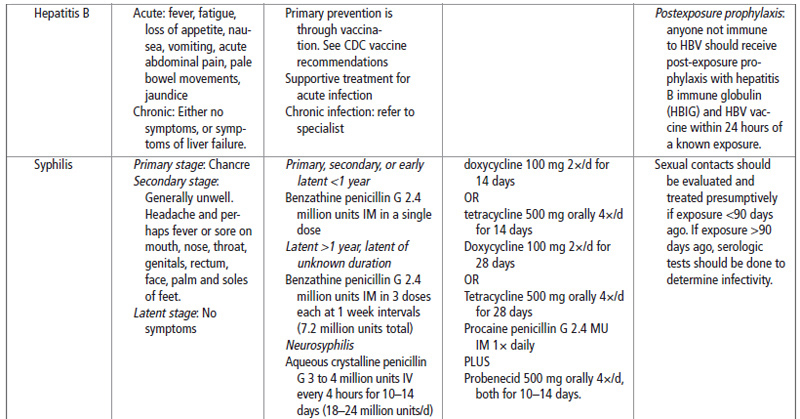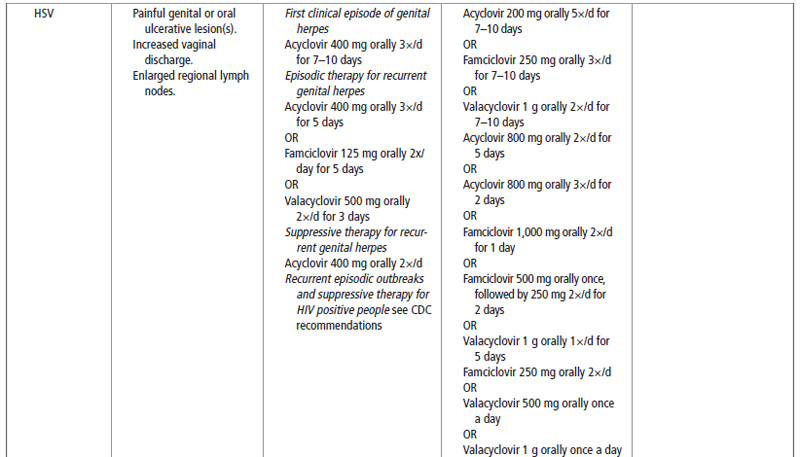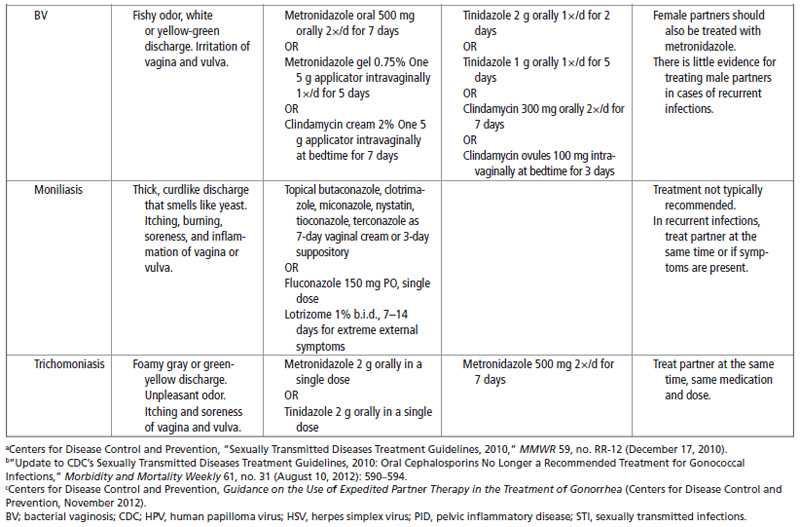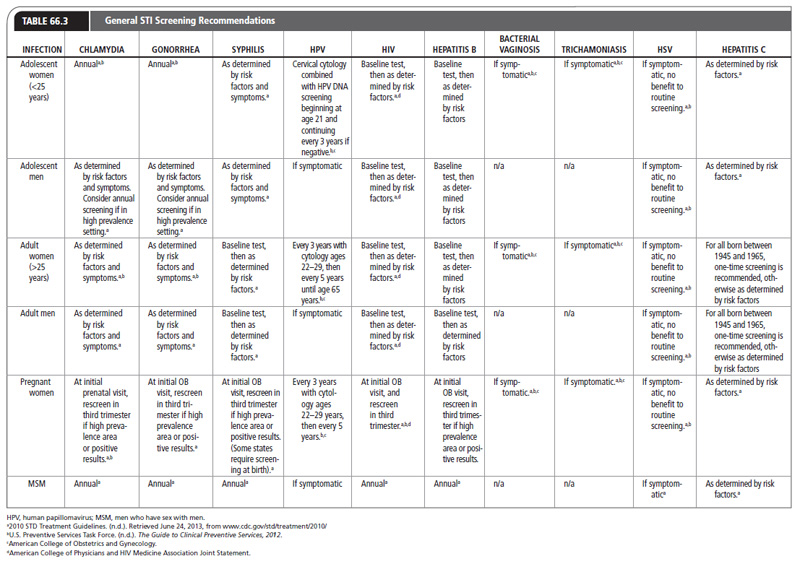CHAPTER 66
Sexually Transmitted Infections
Winifred C. Connerton, PhD, CNM
Sexually transmitted infections (STIs) affect people of all ages and social groupings, and the personal and societal impact of these infections make them a major concern for public health. The term STI encompasses 30 different bacterial, viral, protozoal, and peduncular agents that cause infections that are curable and limited in duration to life-long treatable infections (Rowley, Toskin, & Ndowa, 2012). STIs have been described throughout human history, accompanied by efforts to control their spread (Grob, 1977; Hutto, 2001; Ross, 1995). In 2008, there were more than 110 million STIs in the United States, including 20 million new infections, with a total cost to the health care system of $16 billion (Centers for Disease Control and Prevention [CDC], 2013a). Worldwide, the World Health Organization (WHO) estimated 4.98 million cases of curable STIs in 2008 alone (Rowley et al., 2012).
Federal, state, and local public health agencies monitor select STI outbreaks, and results are tracked and reported on a national level by the Centers for Disease Control (CDC). Providers should know the reporting regulations for their locality, and are obligated to inform their clients of the reportable nature of some infections. Patients may receive follow-up contact from a public health worker to confirm treatment and to assist with partner notification. AIDS; chlamydia; gonorrhea; hepatitis A, B, and C; and syphilis are all reported at a national level to the CDC.
Each STI carries a personal impact for the individual patient in cost of diagnosis and treatment as well as potential stigma and possible lifelong treatment. Beyond the personal impact of STIs there is a social impact found among the consequences of unprotected sexual encounters, including increased risk for all other STIs, unintended pregnancies, cervical and oral cancers, increased rates of infertility and tubal pregnancy, and increased rates of neonatal infection and death. Effective prevention of STIs, coupled with early detection and treatment meet the UN Millennium Development Goals to reduce child mortality, improve maternal health, and to combat HIV (“United Nations Millennium Development Goals,” n.d.).
This chapter begins with a discussion of STIs in general, followed by specific sections covering HIV; STIs that cause cervicitis: chlamydia, gonorrhea, pelvic inflammatory disease (PID), and epididymitis; vaccine preventable STIs: human papillomavirus (HPV) and hepatitis B; ulcerative STIs: syphilis and herpes simplex virus (HSV); and finally those STIs that cause alterations in vaginal discharge: bacterial vaginosis (BV), trichomoniasis, and moniliasis. The CDC guidelines for the treatment and management of STIs is comprehensive, and includes more infections than are included in this chapter, such as pediculosis pubis, hepatitis A, chancroid, and lymphogranuloma venereum. Readers seeking detailed information on these infections, or current management for any of the infections discussed, can find the current guidelines at www.cdc.gov/std/. The anatomy and physiology of the male reproductive system are described in Chapter 67, female reproductive anatomy is described in Chapter 64. The pathology of each of the STIs is discussed in the relevant subsection. Comprehensive epidemiologic statistics are not provided for trichomoniasis, moniliasis, or BV because these are not reportable infections; interested readers are referred to current gynecologic texts. Teaching and self-care is covered in the section on STIs in general.
 SEXUAL HISTORY—A PRIMARY DIAGNOSTIC AND MANAGEMENT TOOL
SEXUAL HISTORY—A PRIMARY DIAGNOSTIC AND MANAGEMENT TOOL
The primary approach to STI management is prevention through reduction of high-risk behavior. A complete sexual history with questions beyond sexual identity is essential to evaluating risk because sexual practices more accurately indicate an individual person’s risk for any particular STI. Recent studies have documented that patients’ self-reported sexual identity does not indicate their actual sexual practice (Pathela et al., 2006; Ross, Essien, Williams, & Fernandez-Esquer, 2003), creating a gap in patients’ self-identification of risk behaviors. The American College of Obstetricians and Gynecologists (ACOG) notes that the incidence of “nonco-ital” sexual acts, including anal intercourse and oral sex, are common among heterosexuals and adolescents, but are often practiced without recommended barrier protections (ACOG Committee on Adolescent Healthcare, 2008). Other studies have noted that heterosexual women practicing receptive anal sex are less likely to use barrier protection than men who have sex with men (MSM; Whitlow, 2004). Women who have sex with women (WSW) were formerly thought to be at low risk for most STIs, but recent evidence indicates that transmission of all STIs is possible between women. Additionally, individual WSW may not have always had, or plan to continue to have, sexual contact exclusively with women (ACOG Committee on Adolescent Healthcare, 2008; ACOG Committee on Health Care for Underserved Women, 2012; Diamant, Schuster, McGuigan, & Lever, 1999). High-risk behaviors and practices are not limited to any single sexual identity; thus, the focus of a sexual history should be actual practices, partners, and methods of protection. See Table 66.1 for suggested questions for a detailed sexual history.
Sexually transmitted infection exposure is sometimes the result of a sexual assault, and providers need to incorporate sexual-assault protocols into their care, including STI prophylaxis and emergency contraception when applicable (ACOG Committee on Health Care for Underserved Women, 2011; CDC, 2010a). Providers should also be aware of forensic evidence collection techniques (aka “the rape kit”) and be prepared to make referrals for collection if not able to perform such a collection themselves.
 EXPEDITED PARTNER THERAPY
EXPEDITED PARTNER THERAPY
Expedited partner therapy (EPT) is the delivery of medications or prescriptions by people diagnosed with an STI directly to their infected sex partners without the clinical assessment of those partners by a health care provider. Providers dispense medications either directly, or by prescription, to treat any potentially exposed partners. EPT has been practiced informally and routinely for many years by individual practitioners and studies of the practice documented increased rates of treatment of infected people, and a reduction in costs associated with treatment, though they note a lost opportunity for counseling when treatment is not associated with a clinical visit (CDC, 2006). The CDC began recommending EPT in 2006, and EPT is now allowed in 35 states, and only explicitly prohibited in 6 states (Florida, Kentucky, Michigan, Ohio, Oklahoma, and West Virginia), with the remaining 9 states and 2 territories potentially allowing the practice (CDC, 2013j).
EPT is recommended as a cost-saving, and effective method for treating partners of those infected with STIs, but it is not without drawbacks. For example, the CDC no longer recommends EPT for partners infected with gonorrhea, and never for partners of MSM. Although EPT is convenient, a physical examination for infected partners should still be offered as well because:
 Partner may be asymptomatically infected with other STIs.
Partner may be asymptomatically infected with other STIs.
 Additional infected partners may be identified and treated.
Additional infected partners may be identified and treated.
 Partners may be allergic to the treatment medication.
Partners may be allergic to the treatment medication.
Practically, providers who participate in EPT should know the limits of their state’s prescribing laws, and should follow the CDC guidelines on appropriate treatments for the specific infection. Providers should supply written information and counseling for the index case, counseling on partner notification methods, as well as a mechanism for patients to report adverse events (ACOG Committee on Gynecologic Practice, 2011; CDC, 2013j). See Table 66.2 for EPT recommendations for specific infections.
Sexual History Taking |
Putting the history in context is helpful: “To understand your risks for STIs, I need to understand the kind of sex you have had recently”; or “Sexual health is important to overall health; therefore, I always ask patients about it. If it’s okay with you, I’ll ask you a few questions about sexual matters now.” | ||
1. | Partners | |
| a. | Do you have sex with men, women, or both? |
| b. | In the past 2 months, how many partners have you had sex with? |
| c. | In the past 12 months, how many partners have you had sex with? |
| d. | Is it possible that any of your sex partners in the past 12 months had sex with someone else while they were still in a sexual relationship with you? |
| e. | Have you or any of your partners ever injected drugs? |
| f. | Have any of your partners exchanged money or drugs for sex? |
| g. | Have you ever been sexually assaulted? When, by whom, what manner, what follow-up? |
2. | STI past history and protection practices | |
| a. | What do you do to protect yourself from STIs and HIV? |
| b. | Have you ever had an STI? |
| c. | Have any of your partners had an STI? |
| d. | Have you ever been tested for HIV? Would you like to be? |
| e. | Have you ever been immunized against hepatitis? Would you like to be? |
3. | Practices | |
| a. | Have you had vaginal sex, meaning “penis in vagina sex”? If yes, Do you use condoms: never, sometimes, or always? |
| b. | Have you had anal sex, meaning “penis in rectum/anus sex”? If yes, Do you use condoms: never, sometimes, or always? |
| c. | Have you had oral sex, meaning “mouth on penis/vagina”? |
| d. | Do you or your partner(s) use any particular devices or substances to enhance your sexual pleasure? |
4. | For condom answers: | |
| a. | If never: Why don’t you use condoms? |
| b. | If sometimes: In what situations (or with whom) do you not use condoms? |
5. | Prevention of pregnancy (if appropriate) | |
| a. | Do you use anything to prevent pregnancy? Are you satisfied with that method? |
6. | Is there anything else about your sexual practices that I need to know about? | |
STI, sexually transmitted infections.
Source: Adapted from CDC (2010) and Nusbaum and Hamilton (2002).
 ANATOMY, PHYSIOLOGY, AND PATHOLOGY
ANATOMY, PHYSIOLOGY, AND PATHOLOGY
STIs are generally transmitted through genital contact, causing symptoms in the genital region, if at all. In women, infections located in the vagina and cervix may cause vaginal discharge, dysuria, and dyspareunia, but many are asymptomatic. Cervical infections, chlamydia and gonorrhea, can ascend to the upper genital tract causing PID, which is the leading cause of infertility in the United States. In adolescents and young women younger than 25 years, the ectocervix has not yet changed from columnar cells to the more protective-type epithelial cells, biologically increasing their vulnerability to the invasion of STIs at the cervix.
Sexually transmitted infections most commonly are found in the genitals, but human sexual behavior creates opportunities for extragenital sites of infection as well, particularly in the oropharynx and rectum. Symptoms of anorectal infections include anal discharge and rectal pain. Pharyngeal STI infection is frequently asymptomatic, but may cause pharyngitis. Finally, some infections are passed sexually, but not generally considered STIs. These include enteric infections spread through oralanal sex, and a recent outbreak of bacterial meningitis in urban MSM communities of the United States (CDC, 2010a; Hartocollis, 2013). These are beyond the scope of this chapter, but serve as reminders that clinicians must be thorough in history taking in order to best evaluate risks and to council patients on modifications for safety and prevention of STIs.
 EPIDEMIOLOGY
EPIDEMIOLOGY
In 2008, there were 110 million STIs treated in the United States, 20 million of which were new infections. The burden of STIs is not distributed evenly across the population. Adolescents and young adults younger than 25 years represent half of new STI infections, while they are only 25% of the sexually active population. Women also have a higher incidence of STIs than men, and women also risk more serious sequelae from the curable infections including PID, tubal pregnancy, and infertility (CDC, 2013a).
 SCREENING
SCREENING
Within the larger population at risk for STIs, certain populations are at heightened risk because of their age, medical condition, or practice of high-risk activities. These groups require altered frequency of screening and attention to modified treatments. Special populations with regard to STI screening include pregnant women, teens, and HIV positive people, but risk behaviors are the main determinant for screening. See Table 66.3 for details of screening recommendations. The U.S. Preventive Services Task Force publishes an annual compilation of screening guidelines, available on the web and as an e-book, here www.ahrq.gov/professionals/clinicians-providers/guidelines-recommendations/index.html.
Young people (aged 15–24 years) are at highest risk of STIs due to behavioral, physiological, and social factors, and they bear a disproportionate burden of these infections, representing half of the approximately 1.9 million new infections per year (CDC, 2013a). All states allow teens seeking screening and treatment to consent for their own care as adults, and parental notification is not required. The physiologic vulnerability of young women coupled with the high prevalence of STIs in this age group has led to the recommendation for yearly chlamydia and gonorrhea testing for women aged 25 years or younger, with or without a pelvic examination. Cervical cancer screening is recommended to begin at age 21 years. Liquid-based cytology can also test for HPV, chlamydia, and gonorrhea. Annual testing for young men is recommended only in areas with high prevalence of chlamydia.
Pregnant women can pass infections to the fetus prior to and during the birth of their child. Screening is timed to allow for treatment during the pregnancy, and for some infections, to ensure prophylaxis during the birth. Specifically, pregnant women should be offered screening for chlamydia, gonorrhea, HIV, syphilis, and hepatitis B at their first prenatal visit. Women with high-risk behaviors, or positive initial results, and all women in high-incidence areas, should be retested in their third trimester for chlamydia, gonorrhea, hepatitis B, and HIV.
MSM are as a group at higher risk for STIs because of participation in high-risk behaviors and high community rates of coinfection. Individual risk should be evaluated through careful history taking, and sexual practices guide the frequency of recommended testing. For example, more frequent screening is recommended for MSM who have multiple or anonymous partners, but not for MSM in monogamous long-term relationships.
 TEACHING AND SELF-CARE
TEACHING AND SELF-CARE
Because of the prevalence and consequences of STIs, all primary care providers need to participate actively in prevention efforts. Sexually transmitted infection education should be included in all routine patient encounters beginning with preadolescents, before sexual activity begins, and should be driven by current research and surveillance data and reevaluated frequently. Vaccines are available for both hepatitis B and HPV, and these should be offered to adolescents and eligible young adults of both sexes to help reduce transmission of these specific STIs, and hepatitis A vaccine should be offered to people coinfected with HIV and hepatitis B (CDC, 2013b).
All sexually active patients need to be informed of how STIs are acquired. Prevention efforts need to target high-risk behaviors and provide appropriate messages. These messages must be repeated often and in a variety of ways, altering the strategies depending on the target audience. Clinical services for prevention education as well as for diagnosis and treatment must be available and effective. Primary care providers can work with local health departments and local schools to provide comprehensive STI services. Primary care providers should implement the recommendations of the U. S. Preventive Services Task Force (2012) and the CDC (2010a, 2012a, 2013a) for prevention, screening, and management of STIs. The CDC publishes an annual sexually transmitted disease (STD) surveillance report. Their guidelines for treating STDs are updated every 3 years, with periodic updates when large changes arise (as with the recent advent of antibiotic resistant gonorrhea strains).
 Sexual identity does not indicate sexual practice. A detailed sexual history is vital to accurate assessment of risk for patient teaching as well as for targeted testing for individual STIs.
Sexual identity does not indicate sexual practice. A detailed sexual history is vital to accurate assessment of risk for patient teaching as well as for targeted testing for individual STIs.
![]() CLINICAL WARNING:
CLINICAL WARNING:
STIs in children (younger than 13 years) are considered evidence of sexual abuse. Consult the CDC guidelines for clinical management and follow local regulations for reporting.
STI exposure may be a result of a sexual assault. Consult guidelines for STI prophylaxis and offer emergency contraception if indicated.
 HIV
HIV
HIV is the retrovirus that causes AIDS. HIV is a chronic, lifelong infection that is primarily spread through sexual contact, but also through exposure to blood and body fluids among intravenous drug users, in occupational exposure at health care settings, and from mother to child in pregnancy and birth. HIV emerged in the United States in the 1981 among MSM, but in other countries it has always been an infection of heterosexual transmission.
The management of HIV/AIDS is a specialty area that is beyond the scope of this chapter (or book), but all STIs increase susceptibility to HIV infection in the uninfected, and STIs increase the risk of transmission of HIV by those infected to their uninfected partners (CDC, 2010b; Fleming & Wasserheit, 1999). HIV also complicates the management of syphilis, and alters the manifestation of other STIs such as HSV and HPV. Prevention is the first-line approach to HIV, and HIV-prevention techniques help prevent transmission of all other STIs as well. The management of HIV disease is described in detail in Chapter 37.
 CHLAMYDIA
CHLAMYDIA
Infection with Chlamydia trachomatis is the most commonly reported STI in the United States with 1,412,791 cases reported in 2011, representing an increase of 8% over the number reported in 2010. Adolescents and young adults (aged 15–25 years) have the highest incidence of infection, numbered at 779, 280 cases in 2011 (CDC, 2012a). The CDC reports that chlamydia is nearly three times as prevalent in young people as adults (CDC, 2013d). Women are the primary target for routine screening because of the significant complications from untreated chlamydia, and because routine screening of men is not cost effective in all settings. Complications of chlamydia in women include PID, tubal factor infertility, and ectopic pregnancy. Pregnant women can transmit the infection to their babies during delivery, potentially causing preterm birth, conjunctivitis, blindness, or pneumonia (CDC, 2013d). The reported rate of chlamydia among women is more than 2.5 times that of men, though this likely reflects the many more women are screened for the infection following CDC guidelines (CDC, 2012a).
Anatomy, Physiology, and Pathology
C. trachomatis is an obligate intracellular parasite, which requires a host cell to live and reproduce. Chlamydia infects cells lining mucous membranes in the cervix, urethra, rectum, pharynx, and eye. Approximately 70% to 95% of chlamydial infections are asymptomatic. If not adequately treated, 10% to 15% of women will develop symptomatic PID, and some men will develop epididymitis (CDC, 2010a, 2013d).
Epidemiology
The CDC has tracked chlamydial infections since 1984, and all 50 states and the District of Columbia require reporting since 2000. The sharp increases in the prevalence of infection since 1984 primarily reflects increased screening, recognition of asymptomatic infection (primarily in women), and improved reporting capacity. The CDC reports 1,412,791 chlamydial infections were reported in 2011 (CDC, 2013h). On a global level, the WHO estimates 105.7 million cases of chlamydia in 2008, and that up to 4,000 newborns per year become blind because of untreated maternal infection (Rowley et al., 2012).
Screening
Symptoms rarely occur in either sex. Women may report symptoms of cervicitis, vaginal discharge, post-coital spotting, or dyspareunia. Men may report symptoms of urethritis accompanied by penile discharge (either watery or mucoid). Rectal infections in either sex are generally asymptomatic but may cause symptoms of proctitis: rectal discharge, pain during defecation (CDC, 2010a).
Because of the high incidence of chlamydial infection among sexually active young women, the CDC’s screening recommends that all women aged 25 years and younger should be tested annually. All other women who are sexually active with a new partner, or who have multiple sex partners should be screened. Screening of men and adolescent boys is only recommended in treatment settings with a high prevalence of the infection (CDC, 2010a).
History and Physical Examination
An accurate sexual history should be performed to identify potential sites of infection for targeted testing, and separate tests should be sent for each potential infection site. The history should also include the presence of an infected partner(s) including any symptoms suggestive of another STI as well as potential allergies to the treatment medication.
A pelvic examination should be offered to women to evaluate for PID as well as testing for other STIs. For men, a physical examination is encouraged to evaluate for other STIs and possible epididymitis, but the examination is less important than treatment.
Diagnostic Studies
Chlamydia cultures are effective diagnostic tools, but the delayed results (3–7 days), cost, and specifics of transport medium and temperature make non-culture tests a better choice in most cases. Non-culture tests include:
 Nucleic acid amplification tests (NAAT)
Nucleic acid amplification tests (NAAT)
 Enzyme immunoassays to detect chlamydia antigens
Enzyme immunoassays to detect chlamydia antigens
 Fluorescein-conjugated monoclonal antibodies for the direct visualization of chlamydia elementary bodies on smears
Fluorescein-conjugated monoclonal antibodies for the direct visualization of chlamydia elementary bodies on smears
 Nucleic acid hybridization tests (DNA probe)
Nucleic acid hybridization tests (DNA probe)
NAATs are the most sensitive of these options, and the CDC recommends NAATs over other specimens for screening from all sites. In addition to superior sensitivity, NAATs offer the option of patient-administered swabs, which may be more acceptable to many patients. Self-administered NAATs are equal to provider-collected specimens for pharyngeal, vaginal, and rectal sites (CDC, 2010a; Sexton et al., 2013; Templeton et al., 2008). NAATs are also available for use on liquid-based cytology specimens (Pap test). Urine NAAT can be performed on a voided specimen produced at least 2 hours after the last micturition (Chernesky, 2005).
Endocervical specimens should be obtained after obtaining Pap smears or cervical cultures if they are to be analyzed apart from a cytology specimen. Specific instructions for the various tests must be followed.
Chlamydial serology has little value in the routine clinical care of genital tract infections. Chlamydial infections elicit long-lasting antibodies that cannot be easily distinguished from the antibodies produced in a current infection.
Treatment Options, Expected Outcomes, and Comprehensive Management
The standard treatment regimen is azithromycin 1 g orally in a single dose (see Table 66.2). Patient should abstain from sexual activity until 7 days after all partners have been treated. Chlamydia may be treated in isolation, but a high index of suspicion should be maintained for potential asymptomatic infection with other STIs.
Everyone with whom the patient has had ongoing sexual exposure within 60 days of the positive test result should be treated. Public health department providers can anonymously contact exposed partners if the patient chooses not to inform them.
Male partners of women with chlamydia who are unable to present for care may be provided antibiotic therapy rather than a prescription. EPT is not recommended for MSM because of the higher incidence of coexisting infections (CDC, 2010a).
Rescreening
Posttreatment testing (test of cure) is only recommended in pregnancy, and should be performed 3 weeks after completed treatment. Reinfection with chlamydia is common, particularly if the partner has not also been treated. Rescreening for reinfection is recommended within 3 months after treatment (CDC, 2010a).
Teaching and Self-Care
Chlamydial infection is highest among adolescents at a rate three times that in the adult population. Community-based prevention programs should target all sexually active adolescents and young adults. These can include school-based programs, adolescent recreation programs, television programs and ads, and newspaper ads. Posters and patient education materials can be placed in settings where there is a high traffic flow of adolescents and young adults. These measures can help promote increased awareness and vigilant screening and treatment. The principal goal is to prevent both overt and silent chlamydial salpingitis and PID sequelae. Prevention of perinatal and postpartal infection is also critical.
Strategies should target infection prevention. Specific strategies include:
 Recommending behavioral changes that reduce the risk of acquiring or transmitting chlamydia such as using condoms for all kinds of sexual contact (vaginal, anal, or oral sex).
Recommending behavioral changes that reduce the risk of acquiring or transmitting chlamydia such as using condoms for all kinds of sexual contact (vaginal, anal, or oral sex).
 Advising teens to delay having intercourse, to decrease the number of sexual partners, and to use barrier contraception
Advising teens to delay having intercourse, to decrease the number of sexual partners, and to use barrier contraception
 In both sexes, chlamydia should be considered in chronic conjunctivitis in adolescents and young adults.
In both sexes, chlamydia should be considered in chronic conjunctivitis in adolescents and young adults.
 Reiter’s syndrome (reactive arthritis, conjunctivitis, and urethritis) is an uncommon complication of untreated chlamydial infection, occurring primarily among men.
Reiter’s syndrome (reactive arthritis, conjunctivitis, and urethritis) is an uncommon complication of untreated chlamydial infection, occurring primarily among men.
 If a posttreatment test is performed using a nonculture test, the test should be scheduled at least 3 weeks after the completion of antimicrobial therapy.
If a posttreatment test is performed using a nonculture test, the test should be scheduled at least 3 weeks after the completion of antimicrobial therapy.
 The preferred collection site for cultures is the endocervix in women, the urethra in men. Cell culture testing is available and highly specific.
The preferred collection site for cultures is the endocervix in women, the urethra in men. Cell culture testing is available and highly specific.
 Active screening and prompt treatment are necessary because infections are typically asymptomatic.
Active screening and prompt treatment are necessary because infections are typically asymptomatic.
 Early recognition of clinical symptoms suggestive of infection, including mucoprurulent cervicitis and urethral symptoms, is important. Treatment is critical for preventing complications.
Early recognition of clinical symptoms suggestive of infection, including mucoprurulent cervicitis and urethral symptoms, is important. Treatment is critical for preventing complications.
 Screening guidelines should reflect prevalence rates within the provider’s geographical area.
Screening guidelines should reflect prevalence rates within the provider’s geographical area.
 GONORRHEA
GONORRHEA
Infection with Neisseria gonorrhoeae bacterium is the second most commonly reported bacterial STI in the United States with 321,849 cases reported in 2011, but prevalence varies widely by communities and populations (CDC, 2012a). Antibiotic resistance has been growing, and the CDC now recommends dual therapy with ceftriaxone and either azithromycin or doxycycline (CDC, 2012a).
Anatomy, Physiology, and Pathology
N. gonorrhoeae is a gram-negative coccobacillus that infects the columnar and transitional epithelial cells of the reproductive and gastrointestinal tracts. Sites of infection include the cervix, uterus, and fallopian tubes in women, and the urethra, pharynx, conjunctivae, and anus in women and men. Like chlamydia, untreated cases of gonorrhea can cause PID with subsequent tubal scarring leading to tubal pregnancy, infertility, and chronic pelvic pain in women, and epididymitis in men. Gonorrhea may also be transmitted to neonates during the birth process causing opthalmia neonatorum.
Epidemiology
Rates of gonorrhea declined nationally beginning in the 1970s after a national control program was instituted, and reached a nadir in 2009, with an increasing rate in all communities after 2010. An estimated 700,000 new infections with gonorrhea occur in the United States each year (CDC, 2010a), and the WHO reports 35.4 million cases worldwide in 2008 (Rowley et al., 2012). The distribution of gonorrhea infection is uneven: Adolescents and young adults (aged 15–24 years) have the highest rates of infection by age, and Blacks have the highest rate of all racial and ethnic groups. Rates of infection are approximately equal among men and women (CDC, 2012a).
Resistant strains of N. gonorrhoeae differ across geographic and social groupings, but the presence of resistant strains around the world has led to recent changes in the recommended treatment regimen (“CDC Grand Rounds,” 2013). Among MSM fluoroquinolone-resistant gonorrhea emerged in the 1990s on the West Coast and began spreading throughout the country, and by 2007, the CDC removed fluoroquinolones from the list of available treatments (Del Rio et al., 2012). In the United States, there is a growing resistance to cefixime and ceftriaxone, in Canada there is a recent report of gonorrhea cases resistant to the last oral antibiotic used for treatment, and in 2009, there was a case report of a Japanese prostitute infected with laryngeal gonorrhea that was resistant to all available treatments (Allen et al., 2013; CDC, 2012c; Groopman, 2012). The CDC notes that the developing pattern of resistance to cephalosporins is similar to the historic pattern of fluoroquinolone resistance a decade earlier (CDC, 2012c). The 2010 CDC guidelines that recommended dual therapy with a cephalosporin and azithromycin or doxycycline to treat potential coinfection with chlamydia have been updated to remove oral cefixime (CDC, 2012e; Del Rio et al., 2012). The updated guidelines and management for resistant strains can be found at www.cdc.gov/std/treatment/2010/.
Screening
The CDC recommends screening all people at risk based on behaviors including sexually activity with multiple partners, and/or exposure to a partner with gonorrhea. Pregnant women should be screened in the first trimester, and again in the third trimester if the initial examination was positive.
History and Physical Examination
History should include questions about actual sexual practices, new partners, and condom use (Table 66.1) to assess risk and to target potential sites of infection.
Gonorrhea is typically asymptomatic in all sites. If a genital infection remains untreated it may progress to PID or epididymitis. Women may report mild, nonspecific symptoms such as dysuria, vaginal discharge, and bleeding, and on examination may have a mucopurulent cervical discharge and cervicitis. Men may report urethritis and a purulent penile discharge within 2 weeks of initial urethral infection. Rectal infection is usually spread through receptive anal sex, but in women genital infection can also spread to the rectum. Rectal infection, generally asymptomatic, may cause discharge, anal itching, soreness, bleeding, or painful bowel movements. Pharyngeal infection can cause pharyngitis, tonsillitis, fever, and cervical adenitis, but is often asymptomatic (CDC, 2013e). Conjunctival infection causes eye irritation with purulent conjunctival exudate.
External female genitalia may demonstrate swelling and discharge from Bartholin’s glands, though this is not diagnostic. In men, the examination includes assessing for discharge and regional lymphadenopathy. The prostate should be palpated for signs of acute prostatitis.
Disseminated gonococcal infection (DGI) is a rare, life-threatening illness and is more common in women than in men. DGI is characterized by fever, arthritis, tenosynovitis (particularly of the small joints of the hands and feet), and/or dermatitis and characteristic hemorrhagic, painful, vesicopustular skin lesions. Less common manifestations include endocarditis and perihepatic involvement (Fitz–Hugh–Curtis syndrome; CDC, 2013e).
Diagnostic Studies
NAATs are the standard diagnostic test for gonorrhea, though they do not provide information on microbial sensitivity. They provide rapid results, frequently can also test for chlamydia, and can be performed on liquid cytology specimens. NAAT urine tests are less invasive than provider-administered tests, and may be preferred by patients. In addition, though NAATs have not been FDA cleared for oropharyngeal or rectal specimens many laboratories have waivers for this examination, and self-administered NAAT swabs may be preferred by patients (Sexton et al., 2013; Wiesenfeld et al., 2001). DNA probes are less sensitive than the NAATs, but can also test concurrently for chlamydia.
Cell cultures may be obtained from the sites of exposure. Cultures are inexpensive and can test for antimicrobial sensitivity, but many facilities do not stock the culture media, and many laboratories no longer process the cultures (CDC, 2012e). Microscopic examination of gram-stained specimen discharge may be diagnostic in clinical settings where this is possible, although this method is less sensitive than cell culture.
Treatment Options, Expected Outcomes, and Comprehensive Management
Refer to the general guidelines presented at the beginning of this chapter for the prevention and control of STIs. Due to the increase in resistant strains of gonorrhea the CDC has issued updates to the 2010 STD treatment guidelines, and providers should be alert for further changes to treatment regimes.
Treatment for urogenital, pharyngeal, and rectal gonorrhea is ceftriaxone 250 mg IM in a single dose PLUS azithromycin 1 g orally in a single dose OR doxycycline 100 mg orally twice a day for 7 days. Table 66.2 gives specific treatment guidelines and alternatives for gonorrhea.
Providers should recommend evaluation and treatment of current partners and those with known sexual exposure over the previous 60 days. The CDC recommends a test of cure 1 week following treatment for anyone treated with an oral therapy. EPT is no longer recommended for heterosexual partners except in cases where the partner cannot be connected with a clinical examination and treatment quickly. In those cases, EPT is recommended over the risk of losing the infected partner to treatment. Anyone receiving EPT should receive a recommendation for a test of cure 1 week later. MSM are not recommended for EPT due to high risk of coexisting STIs in partners (including HIV; CDC, 2012d).
Teaching and Self-Care
See teaching and self-care for chlamydia.
